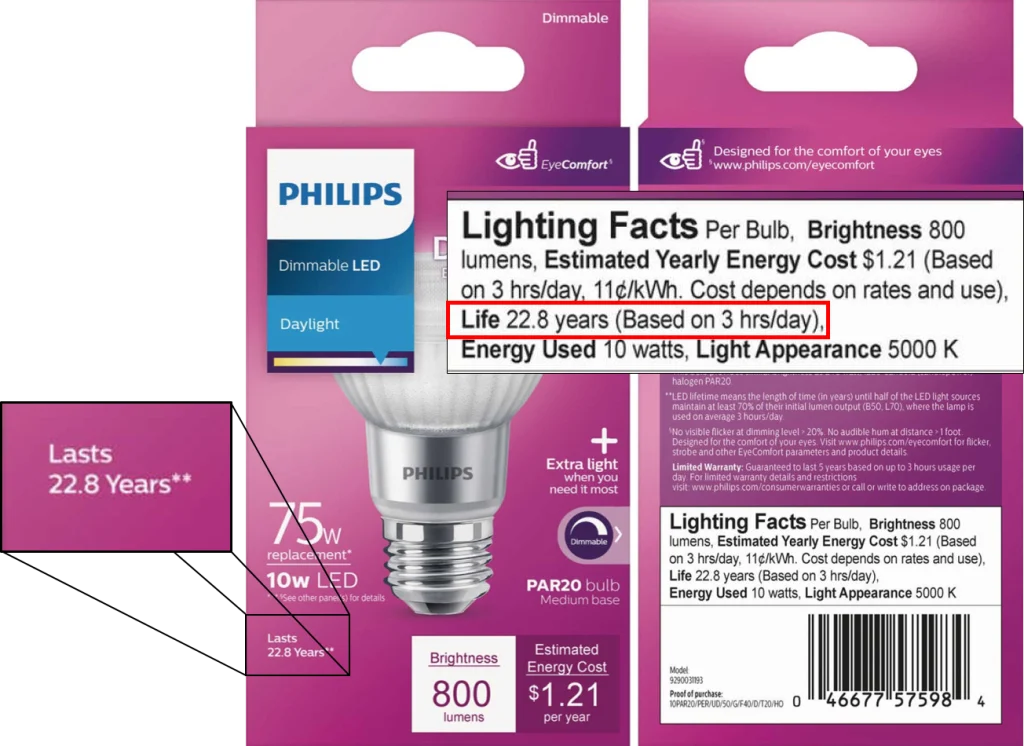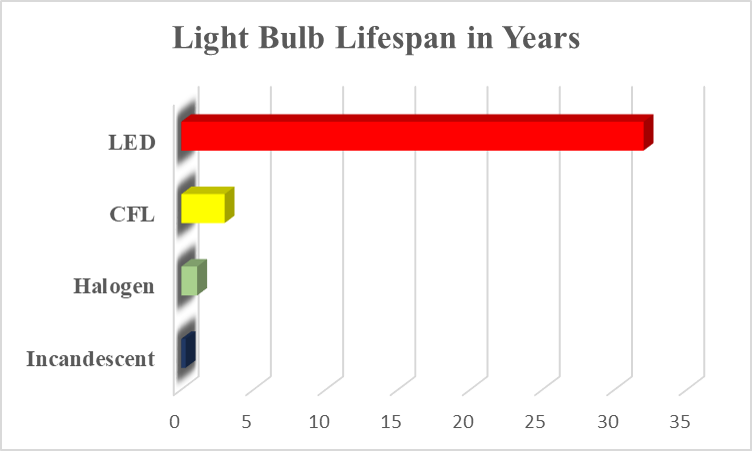LEDs have a very long lifespan. LED lights last longer than incandescent, CFL, fluorescent, or other conventional lights.
The average lifespan of led lights is 50,000 to 100,000 hours. An LED rated at 50,000 hours will last more than 11 years if utilized 12 hours a day. It will last 17 years if used for 8 hours each day! LED lights last 50-100 times longer than a standard incandescent, 20-25 times longer than a standard halogen, and 8-10 times longer than a standard CFL.
LED lifespan is usually measured in hours. But how many years an LED with 50,000 hours last? The high number of hours is often difficult for end users to grasp.
So, in this article, we’ll show you how to turn the hours of operation into a useful number and compare the lifespan of LEDs to that of other light sources.

LED Lifespan: Key facts
- LEDs last up to 100,000 hours
- The actual lifespan depends on the individual period of use. Example: 50,000 hours result in a lifespan of around 16 years with a weekly lighting time of 60 hours
- LEDs don’t fail, they get darker and darker over time
- The number of switching cycles also affects the life expectancy of LED lamps
- An extremely large number of switching cycles and an unsuitable ambient temperature can lead to a defect in the LED
The LED lifespan is usually specified in hours, which declares how long the LED light will last. This information is available on the light’s packaging.
The length of time the LED’s lifetime is spread out depends on how long each light stays on. Because whether you use an LED light for 20, 10, or only 3 hours a day makes a difference.
What does LED Lifespan mean?
The LED lifespan or lifetime is the figure mentioned in hours, which means the light output (brightness) is predicted to drop significantly from the initial output to the point where a replacement is worth considering.
LEDs typically do not burn out completely but rather fade away over time. Even after, say, 50000 hours, 90% of LEDs retain 70 to 80% of their original brightness.
LED lamps fade away after a long lifetime, partly due to the slow aging of the LED driving circuitry. The lifespan of an LED is also affected by things like heat, humidity, power supply, and switching cycles.
How to calculate LED lifespan?
You can easily calculate how long an LED will last based on its expected operating time.
First, calculate your lighting’s weekly and then yearly usage times in hours. Then, all you have to do is divide the rated lifespan of the LED by the annual lighting usage in hours.
For example, this could be 12 hours a day, five days a week. Together, this amounts to 60 hours per week and 3,120 hours per year.
So if the LED lamp has an average lifespan of 25,000 hours, it will glow for around 8 years in your calculation scenario.
LED Lifespan Calculator
How long is 50000 hours lifespan for an LED?
How long will a 50000 hour LED last? Many LED lamps have a declared lifespan of 50,000 hours.
If, as in the calculation example above, we assume a weekly operating time of 60 hours, the 50,000 hours are spread over a period of around 16 years.
LED Lifespan vs other Light Sources
There is a big difference between LEDs and conventional light sources. While lightbulbs, halogen, and energy-saving lamps simply burn out as soon as the end of their service life is reached, LEDs continue to shine.
Because here, the luminosity decreases, the lamp simply becomes darker. You hardly notice this process in practice because it takes place slowly.
But remember: the power consumption stays the same. So you pay the same amount of energy for less luminosity (lumens).
We, therefore, recommend replacing the LED lamp promptly at the end of the calculated service life, even if it still lights up.

| Lamp Type | Lifespan (in hours) | Burn Time (at 70 hours/week) |
|---|---|---|
| Incandescent Light Bulb | 1000 h | 0.3 Years |
| Halogen Lamp | 2000-4000 h | 0.5 – 1.1 Years |
| CFL | 10000 h | 3 Years |
| LED Light | 15000-100,000 h | 4-30 Years |
How to make led lights last longer?
- Pay attention to temperature and humidity:
LEDs are sensitive to heat – so be careful not to expose the LED lamps to extreme temperatures, because excessive cold or heat, as well as too high humidity, can have a negative effect on the LED service life. Therefore, in the technical data on the product pages, pay attention to which temperatures the respective product is designed for. Usually the humidity should be below 80% and the ambient temperature should be in a range between -20 ° C and 30 °. - Use the same type of lamp in one luminaire:
Due to the massive heat generated by light bulbs and halogen lamps, it is advisable not to mix different lamp technologies in one luminaire. Switch directly to LED completely, because you will immediately benefit from high energy savings and the particularly long service life. For more information, please read our blog on fluorescent and LED tubes on the same fixture? 5 reasons against it. - Switch off the lighting as soon as it is not required:
Easy to implement and effective. Because if you only switch on your lights when necessary, the lamps will last longer. This is particularly easy and efficient with sensor-controlled LED lighting . - Use LED-compatible transformers:
If the lamp requires a transformer, it must be compatible with LED. You can obtain the corresponding compatibility lists from the LED manufacturers. - Install correctly:
So that the LED can be cooled sufficiently, it needs space for air circulation. If you install the LED lamp in a housing that is too narrow, excessive heat can develop, which in turn has a negative impact on the service life of the LED. A distance of approx. 1 cm around the lamp is ideal so that the cooling can function optimally.
“How long do led lights last?” People Also Ask
How long do led ceiling lights last?
LED ceiling lights have a typical lifespan of 50,000 to 100,000 hours, which is much longer than traditional incandescent lights.
Do led lights last forever?
No, LED lights do not last forever. They have a typical lifespan of 50,000 to 100,000 hours, which is much longer than traditional incandescent lights. However, even with this long lifespan, the light output of an LED will gradually decrease over time, and eventually, the LED will need to be replaced.
How long do led lights last on batteries?
The lifespan of an LED light powered by batteries depends on several factors, including the type and quality of the batteries, the size and design of the LED light, and the operating conditions.
Typically, the lifespan of batteries in an LED light ranges from several hours to several days, depending on the usage and the batteries type, for example, Alkaline batteries last longer than Lithium batteries but the latter have more power.
However, using rechargeable batteries can increase the lifespan of an LED light powered by batteries, since they can be recharged and used multiple times.
It’s important to note that, the lifespan of batteries in an LED light can also be affected by the manufacturer quality and the design of the fixtures, so it’s recommended to check the product specifications and warranty period for the specific product and manufacturer.
How long do led panel lights last?
In general, LED panel lights that are rated for higher hours, have a longer lifespan than those that are rated for less time, and many manufacturers will specify the expected lifespan of their LED panel lights in the product specifications.
What is the longest lasting LED?
The longest lasting LED lights are typically those that are of high quality, have a good thermal design, and are operated within their recommended temperature range.
However, the longest lasting LED light is subjective as it depends on the usage, the environment and the manufacturer quality.
Does LED light get darker over time?
LEDs don’t just go out at the end of their lifespan, they get darker. To see how much brightness (lumens) there will be at the end of the product life, take a look at the standard for the mean rated life . This indicates how many lumens in percent will be emitted by the LED at the end of its service life. L70, for example, means that 70% of the original lumen value is retained, with the standard L80 it is still 80%. The letter L stands for the decrease in luminous flux. This process is often referred to as degradation.
How many switching cycles does an LED last?
It is not only the service life of the LED chips that has an impact on the service life indicated on the packaging of the light sources. The switching cycles also say something about the longevity of the lamps. In private households there are usually only a few switching cycles per day, so this information is not as relevant here as it is for other applications. A high number of switching cycles can occur particularly in areas of the path where many people are on the move. A prominent example of this are stairwells in large office and residential buildings.
As a rule of thumb you can remember: A lamp has about as many switching cycles as its service life in hours.
What is a switching cycle?
The switching cycle of a lamp consists of switching the lighting on and off . The specification for how many switching cycles a lamp is designed for can also be found on the manufacturer’s packaging.
Can LEDs break?
Yes, LED lamps can break. This happens when the lamp is exposed to an extremely large number of switching cycles , for example due to an incorrectly set motion detector . The ambient temperature also has an impact on the service life of LEDs. When generating LED light, there is usually an extremely low level of heat generation. However, if the LED is installed in such a way that normal air circulation is not possible, heat will build up. The increased ambient temperature can have a negative effect on the service life of the LED and lead to defects.
| tip |
|---|
| If you would like to dispose of defective LED lamps or those that have lost too much luminosity, you have various options. We would be happy to provide you with information on the topic in our blog article Can LED lamps be recycled? |
The longer LED lifespan means less time to change lamps (crucial for hard-to-get-to areas). Also, it’s great for the environment if we need to use fewer lamps and associated packaging, transport energy, and carbon emissions.
So, How long do LED lights last? The answer is, it depends on the manufacturing quality of the LED and its usage.
